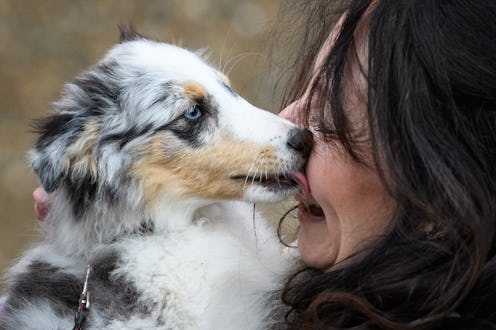Life
Your Dog’s Breed Changes Its Brain In This Weird Way, A New Study Says

Dogs come in all shapes, sizes and breeds, from miniature companion lapdog Pomeranians to the giant mountains of fur that are Newfoundlands — and human breeding has shaped their purpose and traits over centuries. Everything from the retrieving instinct of gun dogs to the herding capability of shepherding breeds has been enhanced over time by humans. Now new science published in the Journal of Neuroscience has shed light on how dog breeds have different brains. It turns out that there isn't one typical dog brain; instead, depending on its breed, your beloved Fido may have a very different brain to Spot and Walter down the street.
The big discovery of the study seems pretty simple, lead author Dr. Erin Hecht of Harvard's Department of Human Evolutionary Biology tells Bustle: "Different breeds of dogs have different brain anatomy." However, that's actually a new idea. Dogs behave very differently according to their breed, and as behavior is determined by the brain, it makes sense that the brains of different breeds would work in different ways — but, Dr. Hecht tells Bustle, nobody had given the idea a scientific look before.
The study wanted to pinpoint exactly what has influenced brain anatomy in dogs. Dr. Hecht and her fellow researchers thought it might be their skull size or shape, as many dogs have very varied head sizes (think of the tiny head of a Chihuahua compared to the wide skull of a bulldog), but they also wanted to investigate another possible factor.
"A third possibility would be that humans have influenced the brain organization of different breeds by selectively breeding them for different behaviors, like hunting, herding, or guarding," Dr. Hecht says. And that factor turned out to be important. "We found that body size and skull shape are indeed factors in determining brain anatomy, but that on top of these two things, there are also significant associations between brain anatomy and the behaviors that different breeds are supposedly specialized for."
They looked at MRI scans of brains of 62 dogs from 33 different breeds. All of them had pretty normal brains — in other words, they didn't show any neurological problems and could be assumed to show typical brain characteristics for their breed. And what they discovered shows that as humans have bred various dog breeds over time, we've actively reshaped their brains.
The MRI scans found that there were six different rough networks of brain regions that worked together in different ways, depending on the breed. "For example, sight hunting, bird flushing and retrieving were linked to a network that included regions involved in vision, movement, eye movement, and spatial navigation, which might support visually tracking a moving object through the environment and then figuring out how to get to it," Dr. Hecht says. In dogs who'd been bred to be great hunters, these brain regions all worked together, while in dogs who weren't retrievers, the regions didn't have the same connection. Companionship dogs had different active networks altogether.
The study found huge variations in brain structure depending on dog breeds, and Dr. Hecht tells Bustle there's something really interesting about that discovery. "As far as we know, none of the dogs in this study were working dogs — they were likely all just family pets," she says. "I think it’s impressive that you can still see these significant brain-behavior links in animals that aren’t actively performing their breed-specific tasks." Even though a Labrador Retriever or a beagle might simply be a pet and live a pretty simple life, their brain still carries a structure created by centuries of breeding. In working dogs, it's likely these specialized brain characteristics are even more enhanced, but no study has been done on that yet.
However, this doesn't mean that every puppy is born with all the capabilities of an adult working dog of its breed already in its brain; you still have to do training, and all dogs have varying capabilities. "Border collies have some innate tendency to learn how to herd but aren’t born herding champions — they have to be exposed to sheep during a critical window early in their development," Dr. Hecht says. "Similarly, humans aren’t born knowing how to use language, but we clearly have an innate predisposition to learn it. If we can figure out how evolution got herding into the brains of border collies, then maybe this will also help us understand how evolution got things like language into our own brains." Dog brains may open up new windows into discoveries about our own cognition and skills.
So next time you look deep into your beloved pooch's eyes and wonder what it's thinking, the answer will likely have been shaped by hundreds of years of selective breeding. Although it may just be thinking about breakfast.